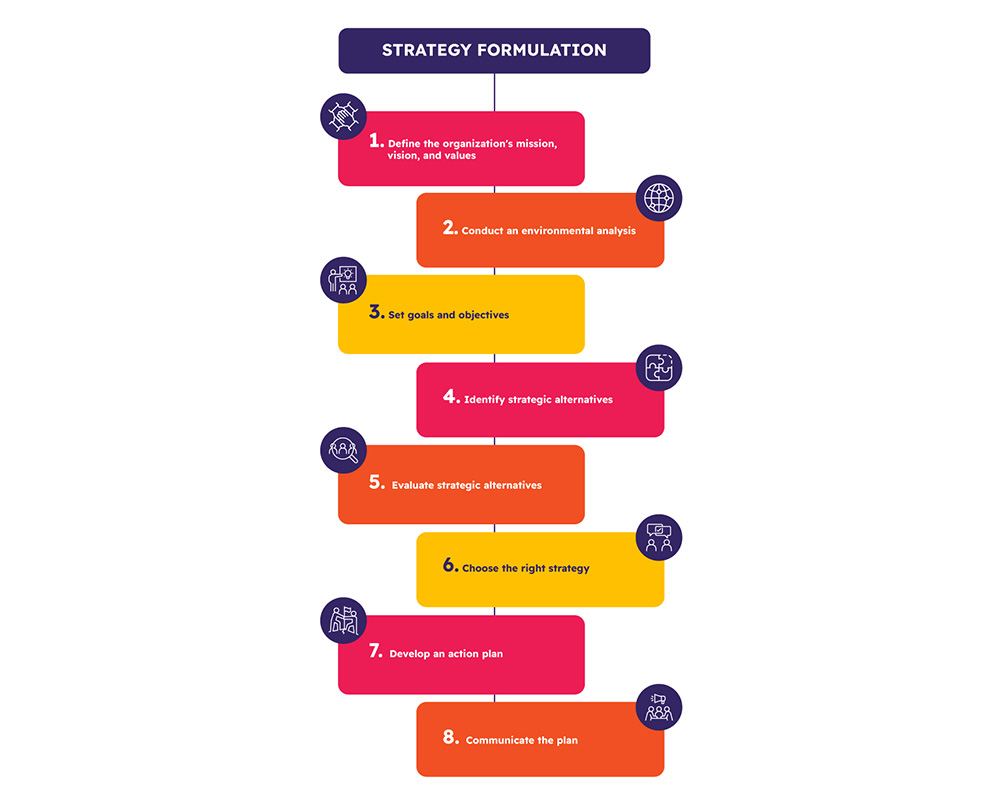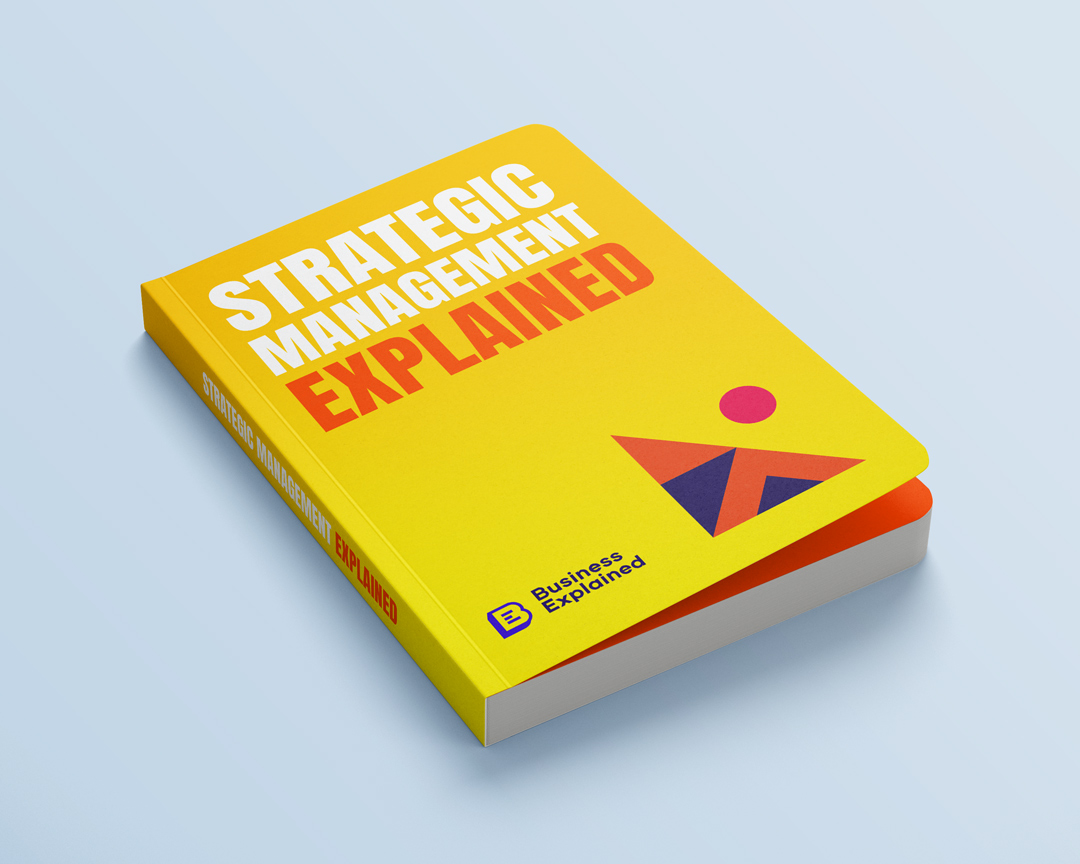Table of Contents
- 5 Stages of Strategic Management Process
- Strategic planning process
- 5 Strategic planning examples
- Strategic management and strategic planning – what is the difference?
- What is a strategic plan?
- How to write a strategic plan?
- Strategic plan template
- Examples of Corporations Implementing Strategic Management
- The Future of Strategic Management
Strategic management involves formulating, implementing, and overseeing an organization’s strategies and plans to achieve its long-term goals and objectives. It entails thoroughly examining the organization’s internal and external environment, making informed choices regarding the business’s trajectory, and efficiently allocating resources to implement those choices.
In this blog post, we’ll explore what strategic management is, delve into its stages, examine the strategic management process, ponder the future of this critical discipline, and look at world-renowned corporations successfully implementing strategic management.
5 Stages of Strategic Management Process
Strategic management usually consists of various stages or steps that guide developing, executing, and overseeing an organization’s strategies. These stages offer a well-organized framework for attaining the organization’s long-term goals and objectives. If you want to find out more about strategic management check out our management ebooks!
These are the typical stages of strategic management:
#1 Goal setting
- Purpose: Establish clear, measurable, and achievable goals that align with the organization’s mission and vision.
- Key Activities: Define short-term and long-term objectives, identify the mission, and set performance targets.
The first stage of the strategic management process is the goal-setting stage. In this stage, organizations establish their long-term direction by defining their vision and mission statements. The vision articulates a future state the organization aims to achieve, inspiring stakeholders and providing a sense of purpose. The mission statement outlines the organization’s core purpose, values, and primary objectives, guiding decision-making and strategic planning. Alongside these statements, organizations develop specific, measurable, achievable, relevant, and time-bound (SMART) objectives to provide clear targets. These objectives ensure all organizational efforts align with the overarching mission and vision, laying a solid foundation for strategic planning and execution.
#2 Environmental scanning
- Purpose: Understand the internal and external environments in which the organization operates.
- Key Activities: Conduct a SWOT analysis (Strengths, Weaknesses, Opportunities, Threats), analyze industry trends, and assess the competitive landscape
Environmental scanning involves a thorough analysis of both internal and external factors that can impact the organization’s strategic planning. Internally, a SWOT analysis helps identify the organization’s strengths, weaknesses, opportunities, and threats, providing a clear picture of its capabilities and areas for improvement. Externally, tools like PESTEL (Political, Economic, Social, Technological, Environmental, Legal) analysis and Porter’s Five Forces framework help assess the broader environment, including market trends, regulatory landscapes, competitive pressures, and socio-economic factors. By understanding these dynamics, organizations can identify opportunities to leverage and threats to mitigate, ensuring their strategies are well-informed and contextually relevant.
#3 Strategy formulation
- Purpose: Develop strategies to achieve the organization’s goals based on the analysis conducted.
- Key Activities: Identify strategic options, evaluate and select the most appropriate strategies, and create a strategic plan.
Strategy formulation is the process of deciding the best courses of action to achieve organizational goals. At the corporate level, this involves determining the overall scope and direction, such as whether to pursue growth, stability, or retrenchment. At the business level, strategies are crafted to position individual business units competitively within their markets, focusing on areas like differentiation, cost leadership, or niche targeting. Functional strategies are then developed to support these higher-level strategies, detailing specific approaches for departments like marketing, finance, and operations. This stage is crucial as it translates broad goals into actionable plans, ensuring coherence and alignment across the organization.
#4 Strategy implementation
- Purpose: Put the formulated strategies into action.
- Key Activities: Allocate resources, assign responsibilities, establish timelines, and ensure communication and coordination across the organization.
Implementation involves putting the formulated strategies into action. This requires effective resource allocation, ensuring financial, human, and technological resources are directed toward strategic initiatives. The organizational structure may need adjustments to facilitate strategy execution, such as creating new divisions or realigning reporting lines. Change management practices are essential to manage transitions, address resistance, and ensure employees are engaged and supportive of the new direction. Effective communication, training programs, and leadership support are critical during this stage to ensure smooth execution and to align the workforce with strategic objectives.
#5 Strategy evaluation

- Purpose: Monitor the effectiveness of the strategy and make necessary adjustments.
- Key Activities: Track progress, measure performance against goals, conduct regular reviews, and make modifications to the strategy as needed.
In the evaluation and control stage, organizations monitor the progress of their strategies through key performance indicators (KPIs) and other metrics. Regular performance reviews and feedback mechanisms help assess whether strategic initiatives are on track to meet objectives. This stage involves comparing actual performance against targets, identifying deviations, and implementing corrective actions as necessary.
Strategic planning process
The strategic planning process is a systematic approach that organizations use to establish their goals and decide how to allocate resources to achieve those goals. It requires analyzing the organization’s current situation, establishing goals and objectives, devising strategies to reach those goals, putting the strategies into action, and tracking progress toward meeting the objectives.
Here’s a breakdown of the strategic planning process and its importance in strategic management:
- Assessment of current situation: This involves analyzing the internal and external environment of the organization, including strengths, weaknesses, opportunities, and threats (SWOT analysis). Understanding the current situation helps in identifying areas where the organization can improve and opportunities it can capitalize on.
- Setting objectives and goals: Based on the assessment, the organization sets specific, measurable, achievable, relevant, and time-bound (SMART) objectives and goals. These provide a clear direction for the organization and help align efforts toward achieving desired outcomes.
- Strategy formulation: This step involves developing strategies to achieve the objectives and goals set earlier. Strategies may include market expansion, product diversification, cost leadership, differentiation, or other approaches tailored to the organization’s circumstances.
- Implementation of strategies: Once strategies are formulated, they need to be implemented effectively. This involves allocating resources, assigning responsibilities, and establishing timelines and milestones to ensure that the strategies are executed as planned.
- Monitoring and evaluation: Continuous monitoring and evaluation of the strategic plan are crucial to assessing progress towards goals and objectives. This helps in identifying any deviations from the plan and taking corrective action as needed. Key performance indicators (KPIs) are often used to measure progress and performance.
- Adaptation and review: The strategic planning process is not a one-time event but rather an ongoing cycle. Organizations need to regularly review and adapt their strategies in response to changes in the internal and external environment, ensuring that they remain relevant and effective.
5 Strategic planning examples
Here are five examples of strategic planning in different contexts:
- Business expansion strategy:
- Objective: To expand into new markets and increase market share.
- Strategy: Conduct market research to identify potential markets with high demand for the product/service. Develop a market entry strategy (e.g., partnerships, acquisitions, or direct market entry). Allocate resources for marketing, distribution, and customer support in the target markets.
- Implementation: Establish partnerships with local distributors, launch targeted marketing campaigns, and adapt products/services to meet local preferences.
- Monitoring and Evaluation: Track sales performance in the new markets, monitor customer feedback, and adjust strategies as needed to improve market penetration and profitability.
- Nonprofit fundraising strategy:
- Objective: To increase fundraising revenue and support organizational programs.
- Strategy: Segment donors based on giving patterns and preferences. Develop personalized fundraising campaigns tailored to each donor segment. Utilize multiple fundraising channels (e.g., events, online donations, corporate sponsorships) to diversify revenue streams.
- Implementation: Launch targeted email campaigns, organize fundraising events, and leverage social media platforms to engage donors and solicit donations.
- Monitoring and Evaluation: Track donation trends, measure campaign effectiveness (e.g., donation conversion rates, average donation size), and adjust fundraising strategies based on performance data.
- Government strategic planning:
- Objective: To improve public health outcomes in a specific region.
- Strategy: Conduct a needs assessment to identify health priorities and gaps in service delivery. Develop a comprehensive health promotion and disease prevention strategy. Collaborate with healthcare providers, community organizations, and policymakers to implement interventions.
- Implementation: Launch public awareness campaigns on preventive health measures, expand access to healthcare services in underserved areas, and implement policies to regulate unhealthy behaviors (e.g., smoking bans, sugar taxes).
- Monitoring and Evaluation: Track key health indicators (e.g., vaccination rates, disease prevalence), conduct surveys to assess public awareness and behavior change, and evaluate the impact of interventions on health outcomes.
- Educational institution strategic planning:
- Objective: To enhance student success and academic excellence.
- Strategy: Conduct a comprehensive assessment of academic programs, student support services, and institutional resources. Develop strategies to improve teaching and learning outcomes, enhance student engagement, and support student retention and graduation.
- Implementation: Implement faculty development programs to enhance teaching effectiveness, enhance advising and mentoring services for students, and invest in technology infrastructure to support online learning and student services.
- Monitoring and Evaluation: Track student performance metrics (e.g., graduation rates, academic achievement), conduct student satisfaction surveys, and assess the effectiveness of academic programs and support services through program evaluations and feedback mechanisms.
- Technology company strategic planning:
- Objective: To maintain competitive advantage and drive innovation in the technology industry.
- Strategy: Invest in research and development to develop cutting-edge technologies and products. Expand market reach through strategic partnerships and alliances. Continuously assess market trends and customer needs to anticipate changes and adapt product offerings accordingly.
- Implementation: Develop a product roadmap outlining new product releases and feature enhancements. Forge partnerships with other tech companies, universities, and research institutions to leverage complementary expertise and resources
- Monitoring and Evaluation: Track product adoption rates, monitor competitor activities, and solicit customer feedback to identify areas for product improvement and innovation.
These examples illustrate how strategic planning can be applied across various sectors to achieve specific objectives and drive organizational success. Each strategic plan is tailored to the unique circumstances and goals of the organization, reflecting a systematic approach to decision-making and resource allocation.
Strategic management and strategic planning – what is the difference?
Strategic planning is a component of strategic management. It focuses on ensuring that a company has a clear direction and the necessary resources to achieve its objectives. While strategic planning defines ‘what’ the goals are and ‘why’ they are important, strategic management goes further to address ‘how,’ ‘when,’ and ‘who’ will be involved in executing and adjusting the plans.
| Aspect | Strategic Planning | Strategic Management |
|---|---|---|
| Definition | Determining the main direction and resource allocation. | Implementing plans and making adjustments as necessary. |
| Focus | Setting priorities and establishing goals. | Executing, monitoring, and revising strategies. |
| Scope | Narrower, primarily focused on plan creation. | Broader, encompassing the entire process from planning to execution. |
| Activities | Defining strategy, setting goals, and allocating resources. | Executing the plan, monitoring progress, and revising strategies as needed. |
| Outcome | Creation of a roadmap for future success. | Ongoing alignment of the company’s strategy with its goals amidst changes. |
What is a strategic plan?
A strategic plan is a comprehensive document that outlines an organization’s direction, goals, and strategies for achieving those goals over a specified period, typically three to five years. It serves as a roadmap for the organization, providing guidance on how to allocate resources, make decisions, and measure progress toward its objectives.
A strategic plan provides a structured framework for guiding organizational decision-making, aligning efforts toward common goals, and driving long-term success and sustainability. It serves as a valuable tool for leaders, managers, and stakeholders to chart the course for the organization’s future and navigate challenges and opportunities effectively.
How to write a strategic plan?
Writing a strategic plan is a vital step for any organization seeking to define its direction and achieve its objectives. Begin by conducting a thorough analysis of your organization’s internal strengths and weaknesses, as well as external opportunities and threats. Use tools like SWOT and PESTLE analysis to gain insights into your current position and the broader business environment. With a clear understanding of your context, set ambitious yet achievable long-term objectives, supported by specific short-term goals.
Next, formulate strategies that leverage your strengths to capitalize on opportunities while addressing your weaknesses and mitigating threats. Develop an action plan outlining the steps needed to implement each strategy, assigning responsibilities, setting timelines, and allocating resources accordingly. Regularly monitor progress against key performance indicators, evaluating the effectiveness of your strategies and making adjustments as necessary. Finally, ensure effective communication of the strategic plan to all stakeholders, fostering alignment, engagement, and commitment to its successful execution.
With careful planning and execution, a strategic plan serves as a roadmap for navigating challenges, seizing opportunities, and driving sustainable growth and success for your organization.
Strategic plan template
This strategic plan template offers a structured framework for organizations to express their vision, establish clear objectives, and create actionable strategies to reach their goals. Through a thorough analysis of internal and external factors, defining strategic priorities, and implementing robust monitoring and evaluation mechanisms, this template enables organizations to adjust, innovate, and succeed in a constantly evolving environment.
Here’s a basic template for a strategic plan:
| Section | Description |
|---|---|
| Executive Summary | A concise overview of the strategic plan, highlighting key points, goals, and strategies. Provides a snapshot for stakeholders. |
| Introduction | |
| Mission Statement | A clear and concise statement of the organization’s core purpose and values, explaining why it exists and what it aims to achieve. |
| Vision Statement | A forward-looking statement describing the desired future state of the organization, providing inspiration and long-term direction. |
| Core Values | Fundamental beliefs and principles guiding the organization’s behavior and decision-making processes. Shapes the culture and identity. |
| Environmental Analysis | |
| SWOT Analysis | Assessment of internal strengths and weaknesses, and external opportunities and threats, to understand the current position and areas for improvement. |
| PESTLE Analysis | Analysis of external macro-environmental factors (Political, Economic, Social, Technological, Environmental, Legal) affecting the organization. |
| Goal Setting | Specific, measurable, achievable, relevant, and time-bound (SMART) goals and objectives that the organization aims to achieve. |
| Long-term Objectives | Goals to be achieved over 3-5 years. |
| Short-term Goals | Goals to be achieved within 1 year. |
| Strategy Formulation | Detailed plans and actions outlining how the organization will achieve its goals and objectives. Includes key initiatives, projects, and programs. |
| Action Plan | Step-by-step plans detailing specific actions needed to implement strategies, including timelines, responsibilities, and resource allocation. |
| Resource Allocation | Detailed plan for the allocation of financial, human, and technological resources required to implement strategies and action plans. |
| Performance Measures | Key performance indicators (KPIs) and metrics used to monitor progress and measure the success of the strategic plan. |
| Risk Management | Assessment of potential risks and challenges that could impact the strategic plan, including mitigation strategies. |
| Communication Plan | Plan for communicating the strategic plan to stakeholders, ensuring alignment with organizational goals. |
| Implementation Timeline | Detailed timeline outlining key milestones and deadlines for implementing strategies and action plans. |
| Evaluation and Review | Process for regularly reviewing and evaluating the progress of the strategic plan, including feedback and adjustments. |
Remember, this template can be adapted and customized based on the specific needs and circumstances of your organization.
Examples of Corporations Implementing Strategic Management
- Apple Inc.: Apple’s relentless focus on innovation, product differentiation, and customer experience has made it a global leader. Their strategic management revolves around launching groundbreaking products like the iPhone and iPad while maintaining a strong brand image.
- Amazon: Amazon’s strategic management includes continuous expansion into new markets and industries, such as cloud computing (AWS) and streaming services (Amazon Prime Video). Their customer-centric approach and logistics excellence are key elements of their strategy.
- Google: Google’s strategy emphasizes innovation through ventures like Google X and maintaining a dominant position in the online search market. Their acquisition of companies like YouTube and Android showcases their strategic diversity.
Ultimately, strategic management serves as the guiding force that directs organizations toward their long-term goals. It requires a methodical approach of analyzing, strategizing, implementing, and assessing. Digital transformation, sustainability, and agility are expected to play a significant role in shaping the future of strategic management. As observed in the remarkable achievements of industry leaders such as Apple, Amazon, and Google, adept strategic management can pave the way for market supremacy and sustained expansion in a rapidly evolving business landscape.
The Future of Strategic Management
Strategic management is set to undergo significant changes in the coming years, influenced by a range of trends and factors that mirror the dynamic nature of the business world and advancements in technology. Although it is difficult to predict the path ahead accurately, there are several important themes and potential developments that may have an impact on the future of strategic management:
- Digital Transformation: The increasing importance of digital technologies will continue to impact strategic management. Businesses must integrate digital strategies, data analytics, and emerging technologies like artificial intelligence (AI) and blockchain into their strategic planning processes.
- Agile and adaptive strategies: Traditional long-term strategic planning may evolve towards more agile and adaptive approaches. Businesses may need to become more responsive to rapid changes in market conditions, customer preferences, and technological advancements.
- Environmental and social responsibility: Sustainability and corporate social responsibility (CSR) are becoming integral to strategic decision-making. Organizations will need to consider their environmental and societal impact and align their strategies with sustainable practices.
- Globalization and geopolitical shifts: The global business landscape will continue to evolve, driven by geopolitical shifts and trade dynamics. Companies will need to navigate international markets, trade policies, and geopolitical risks when formulating their strategies.
- Data-driven decision-making: The importance of data analytics and predictive modeling in strategic management will grow. Businesses will use data to make more informed decisions, optimize operations, and identify new opportunities.
- Ecosystem strategies: Collaborative partnerships and ecosystem strategies will become more prevalent. Organizations may need to work closely with other businesses, startups, and industry partners to access new markets and technologies.
- Customer-centricity: The focus on understanding and meeting customer needs will remain paramount. Customer-centric strategies, driven by personalization and customer experience improvements, will continue to shape business strategies.
- Disruption and innovation: The pace of technological innovation and industry disruption will require organizations to be more innovation-oriented. Strategies may revolve around continuous innovation to stay competitive.
- Talent and skills: Strategic management will need to address talent acquisition and development. Attracting and retaining skilled employees will be crucial, especially in technology-driven industries.
- Cybersecurity and risk management: With the increasing reliance on digital technologies, strategic management will need to incorporate robust cybersecurity measures and risk management practices to protect assets and reputations.
- Regulatory changes: Businesses must navigate evolving regulatory landscapes, particularly in sectors like finance, healthcare, and technology, which face constant regulatory changes.
- Crisis management and resilience: Strategic planning will include provisions for crisis management and building organizational resilience to respond effectively to unexpected events, such as pandemics, cyberattacks, or natural disasters.
- AI in decision support: AI-driven tools may play a more significant role in supporting strategic decision-making by analyzing vast amounts of data, identifying trends, and offering insights.
- Ethical AI and automation: As automation and AI become more integrated into business processes, organizations must address ethical considerations and ensure responsible AI usage in their strategies.
In the future, strategic management will be marked by adaptability, evidence-based analysis, environmental awareness, technology integration, and a focus on meeting customer needs and benefiting society. Businesses that can adapt and innovate in response to these trends are more likely to achieve lasting success in a dynamic business environment.
At Business Explained, we provide valuable insights into strategic management and many other business topics through our eBooks and digital tools. Explore our range of digital products to unlock the potential for growth and success in your organization.






 Risk-free Purchase: Full refund within 14 days
Risk-free Purchase: Full refund within 14 days